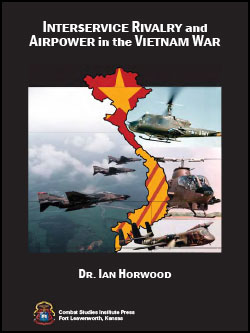
By Dr. Ian Horwood
210 Pages
Published: 2006
The Combat Studies Institute is pleased to publish this special study, Interservice Rivalry and Airpower in the Vietnam War, by Dr. Ian Horwood. Dr. Horwood, a British historian, has explored the rivalry between the armed services of the United States relating to the employment of tactical airpower during the Vietnam War. Not being an American, he is able to put a fresh perspective on this complex issue.
This study focuses on tactical airpower in South Vietnam between 1961 and 1968. Dr. Horwood avoids a lengthy discussion of the air war over North Vietnam, focusing instead on the combat operations in the South. Interservice Rivalry and Airpower in the Vietnam War examines a number of issues which are relevant to the use of airpower in irregular warfare. Among them are command and control of airpower, the use of airpower at the tactical and the operational-strategic level of war, the role of helicopters, and different service understandings of the proper role of airpower in a counterinsurgency.
The Army is, of course, keenly interested in the air-ground integration as it performs its role in achieving military success on the ground. Always contentious since its invention a century ago, the proper role for airpower in war is even more complex in the irregular wars which the US has faced since the end of the Cold War, and which it faces today in the Long War. We at CSI believe this study will provide useful insights for military professionals. CSI- The Past is Prologue!
Download the PDF 